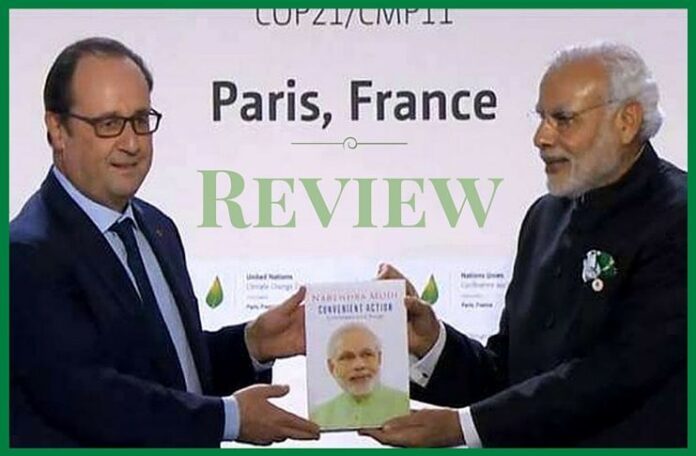
[dropcap color=”#008040″ boxed=”yes” boxed_radius=”8px” class=”” id=””]A[/dropcap]s India and the world have had their eyes on Prime Minister Narendra Modi from even before the crucial Conference of Parties-21 (CoP-21) UN Climate Change Conference began, he was conveniently seen saying that climate change was “not of India’s making”.
Global environment watch-dog Greenpeace said although India’s emissions could be low compared to the “developed”, it needs to secure a deal as “it is paying the price”. Even as the country’s capital, New Delhi, has been termed the world’s most polluted city, according to a study by the World Health Organisation (WHO), the international media dubbed India as a “villain” and “spoiler” during the much anticipated CoP-21.
India’s stand that the deal which will emerge at the end of the conference will be “equitable, but with differentiated responsibilities” is being taken with a pinch of salt by the world media.
“Convenient Action: Continuity for Change” [(LexisNexis, 203 pp, Rs.995 ($14.90)] — authored by the prime minister — which was launched recently in Paris before the global leaders as the CoP-21 proceeded, assumes a similar convenient tone – more of Gujarat, where he spent three terms as a chief minister, but very little of India – and has very little to say about the rest of the country, except for a mention of a ‘green’ building in Delhi and a picture of a rig in the Krishna Godavari basin.
This book is a sequel, a revised and updated version of “Convenient Action”, which Modi wrote in 2010 as the Gujarat chief minister.
[dropcap color=”#008040″ boxed=”yes” boxed_radius=”8px” class=”” id=””]T[/dropcap]here is no mention of any energy-related projects taken up or their status in any other part of the country, despite the book being launched at the time of the crucial global climate change conference, where India was positioning itself as a important game-changer.
Introducing the updated book, Modi writes: “One year (as prime minister) is definitely not enough to reap far-reaching fruits. However, with an updated information on Gujarat, I have delineated towards the end of this book a series of actions and policy measures that have been initiated during the last one year which will have definite and incremental effects on our preparedness to deal with climate shocks in future.”
As the prime minister begins the chapter ‘Climate Ethics’, he draws uncanny parallels between UN reports, which term climate change as an “unsustainable ecological debt”, and Atharva Veda, from which he quotes a few lines hailing “Mother Earth”.
“The suktas of Atharva Veda had embodied the very same message thousands of years ago,” Modi writes.
He also makes India’s stand at the CoP-21 clear through the book, by quoting UN Secretary General Ban Ki-moon, saying that there can be no model that “fits all”, and that “culture” was not taken into consideration in the Millennium Development Goals (MDGs/2000-2015).
[dropcap color=”#008040″ boxed=”yes” boxed_radius=”8px” class=”” id=””]T[/dropcap]he book hails Gujarat’s model with examples from various districts of the state – and stands as nothing less than a state brochure. It presents the dam height and increase in storage level of the Sardar Sarovar Project, some glossy images of recreational spots around the Sabarmati river, and various other ‘green’ projects of the state and their “success” stories.
To be fair, a March 2015 report of India’s Ministry of Statistics and Programme Implementation says Gujarat ranks in its ability to produce renewable energy only after Tamil Nadu and Maharashtra.
Towards its conclusion, the book also lists the prime minister’s “foreign collaborations” on climate change which in reality are only “proposed collaborations” and “decisions to enhance high-level dialogue”.
Notes:
1. IANS
2.The conversion rate used in this article is 1 US Dollar = 66.75 Rupees.
- Pentagon cancels aid to Pakistan over record on militants - September 2, 2018
- The curious case of Tamil Nadu’s opposition to NEET - September 4, 2017
- If 2.6 Billion People Go To War: India vs. China - July 22, 2017










